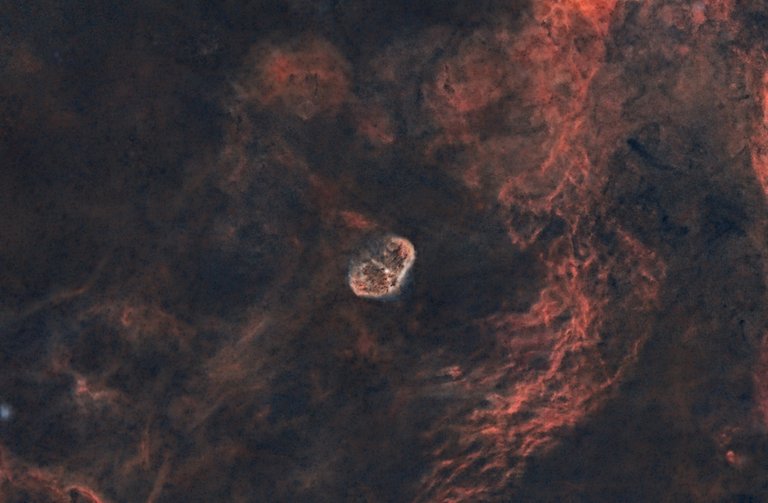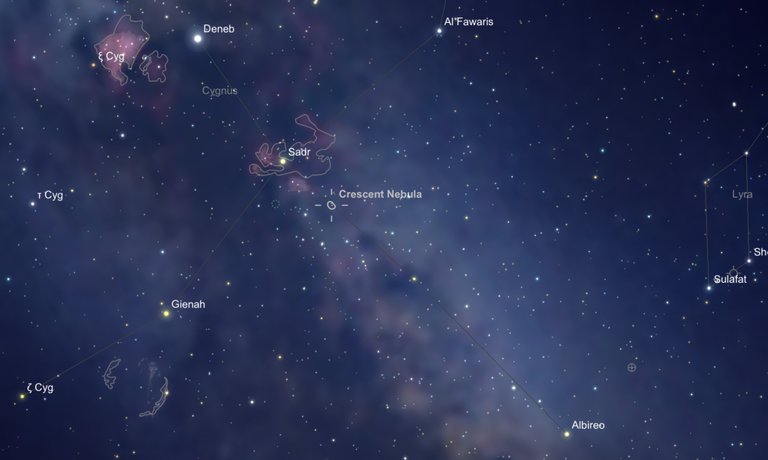The Cresent Nebula (NGC6888) is a bigger (regarding its apparent size) Emission Nebula and is located in the constellation of Cygnus, approximately 4,700 light-years away from us. As already written in my previous posts, the constellation of Cygnus itself is placed in a highly active and dense region of our Milky Way, which contains many interesting objects and countless stars.
In 1792 the Crescent Nebula was discovered by Wilhelm Herschel. Almost a hundred years later, in 1888, it was numbered with 6888 in the then published New General Catalogue of Nebulae and Clusters of Stars (NGC).
In the "center" of the Cresent Nebula is the Wolf-Rayet star WR 136, which is believed to have created this emission nebula by rejecting significant parts of its matter. The gases released by the star, mostly hydrogen (red in the image) and also a bit of oxygen (very faint blue in the image, nearly invisible), are ionized by its radiation and therefore stimulated to illuminate light in their corresponding wavelengths.
The Cresent Nebula captured with a focal length of 420mm.

Click on the image for a larger view ▲
Wolf-Rayet stars are the remaining nuclei of massive stars that have repelled or are still repelling their matter respectively their gases. So far, Wolf-Rayet stars with 10 to 265 times the mass of our sun have been discovered. Their measured and calculated surface temperatures range from 30,000 to 120,000 degrees Kelvin.
The Cresent Nebula lies in the foreground of an enormous cloud complex out of ionized gases and dust. As mostly all other objects in the constellation Cygnus, you can't see this background complex very well due to the very high number of stars. To make this background cloud complex more visible, I removed the stars in the picture.
My attempt to remove the stars so that the background nebula can be recognized better.

Click on the image for a larger view ▲
As mentioned above the cloud complex is huge. Its measured size in Aladin is around 6.5 by 13 degree. For comparison, the full moon will cover an area of about 0.5 degrees in diameter on the night sky.
For visualization, you can find the Cresent Nebula in the center of the Aladin Sky Atlas screenshot. It is the small bubble-like object in front of the gigantic molecular cloud. You can also see the North America Nebula in the upper left and the Eastern Veil Nebula on the lower left side.
The whole background nebula complex. Screenshot of Aladin Sky Atlas.

Click on the image for a larger view ▲
This time I won't make an extra picture with labeling, because the "interesting" objects focus on the Emission Nebula NGC6888 (Cresent Nebula) and the Wolf-Rayet star WR136, which can be easily recognized.
Position in the night sky
As the North America Nebula, the Eastern Veil Nebula, and as mentioned above the Cresent Nebula is also part of the constellation Cygnus. I tried to get approximately the same field of view as in the Aladin Sky Atlas screenshot.
Position of the Cresent Nebula in the night sky. Screenshot of SkySafari Plus app for iOS.

Click on the image for a larger view ▲
Details of the image
The picture was taken in my Backyard with the following equipment and settings.
| Camera | QHYCCD247C |
| Telescope | TSAPO65Q · 420mm · f6.5 |
| Filter | STC Duo-Narrowband Filter (48mm / 2") |
| Guide camera | QHY5L-II |
| Guide scope | TSL60D · 240mm · f4.0 |
| Mount | Skywatcher AZ EQ-6 |
| Exposure time | 19 x 600" = 190 minutes = 3 hours 10 minutes |
| ISO | Unity Gain @ -20°C |
Everything is controlled by my Astro-PC via remote desktop and wireless LAN.
Software: Sequence Generator Pro, PixInsight, Photoshop CC
The license of my pictures
All images, otherwise clearly indicated, in this post are my own work.
You can use it for free if you credit them to @astrophoto.kevin.
 Attribution-ShareAlike 4.0 International (CC BY-SA 4.0)
Attribution-ShareAlike 4.0 International (CC BY-SA 4.0)
References
https://aladin.u-strasbg.fr/AladinDesktop/
https://de.wikipedia.org/wiki/Wolf-Rayet-Stern
https://www.universeguide.com/star/wr136
https://de.wikipedia.org/wiki/NGC_6888
https://chandra.harvard.edu/photo/2003/ngc6888/
https://de.wikipedia.org/wiki/Scheinbare_Gr%C3%B6%C3%9Fe
Thank you very much for reading!
If you have any questions or suggestions, please don’t be afraid to let me know of anything you thought about this post in the comments below!
Yours, @astrophoto.kevin

SteemSTEM is a community project with the goal to promote and support Science, Technology, Engineering and Mathematics on the Steem blockchain. If you wish to support the steemSTEM project you can:
Contribute STEM content using the #steemstem tag | Support steemstem authors | Join our curation trail | Visit our Discord community | Delegate SP to steemstem
Beeindruckende Aufnahmen, für die man sehr viel Geduld braucht! Respekt!
Vielen Dank lieber Peter :-)
An die Geduld habe ich mich inzwischen gewöhnt, an die schlaflosen Nächte allerdings noch nicht so ganz :-)
Dass stayout dich für diesen Post flagged, kann ich nur dadurch erklären, dass er an dir Rache nimmt. Was ist das nur für ein Mensch?
Ich hab bis jetzt noch immer mit einem Flag gekontert, wird mir aber zu blöd. Wenn er meint er muss mit diesem Kindergarten weiter machen, dann bitte.
Kindergarten ist das richtige Wort für sein Verhalten.👍
Truly fantastic pic. It's hard to believe regular technology can accomplish such results. Nice job!
Thank you very much @mobbs :-)
Amateur technology has made a huge step in the last 10 years. It's great what can be done with normal consumer hardware.
Once again, an amazing shot! So red!
Thank you very much @lemouthe :-)
Yes, there is a lot of ionized Hydrogen in the background and in NGC6888 itself.
I am not surprised to find Hydrogen all over the place, in fact :D
Eine Belichtungszeit von über 3 Stunden? Respekt. Tolle Aufnahmen auf jeden Fall. Ich frag mich manchmal, gibt es dort Lebewesen die unsere Galaxie auch so lange belichten und dann die Fotos auf einer steemit ähnlichen Plattform dort teilen? Unmöglich ist es definitiv nicht.
Posted using Partiko Android
Vielleicht gibt es ja ein gespiegeltes Universum, wo dasselbe wie hier passiert. Wir werden es wohl nie erfahren.
Nie würde ich nicht sagen, vielleicht wird es Möglichkeiten geben,wie wir schneller reisen könnten. Quantenphilosophie ist ein interessantes Gebiet.
Posted using Partiko Android
Das Problem sind allerdings immer die Energien die Benötigt werden um solche Massen zu bewegen bzw. den Raum um die Masse zu bewegen.
Aber du hast recht, wer weiß was noch alles entdeckt wird und wie sich das noch nutzen lässt.
Stimmt, man soll niemals "nie" sagen! Alles in allem schon sehr interessant sich damit zu beschäftigen.
Ich möchte noch mal kurz nachfragen: hast du meine Nachricht im discord gelesen? Ich habe fast den Verdacht, dass ich die Nachricht an die falsche Adresse geschickt hab.
Schick sie mir doch bitte nochmal. Danke! 👍
Vielen Dank @thales7 :-)
Das könnte gut möglich sein. Ich bin ja fest davon überzeugt, dass es da draußen auch noch anderes Leben geben muss. Allerdings wird es wohl nie zu einem Kontakt kommen, dazu sind die Entfernungen zu groß.
Let's hope this doesn't make the image to shaky:
!BEER
We hope it :-)
Cheers ;-)
!BEER
View or trade
BEERat steem-engine.Hey @isnochys, here is a bit
BEERfor you. Enjoy it!Those images are great ..! I hope you can share many more soon :D
Thank you very much for your kind words @carloserp-2000 :-)
I hope it too. The next few weeks my scope is completely disassembled because I bought a new focuser and need to wait until my self designed adapter is built. At least this will give me some time to finalize my Astro PC.
This post has been manually curated by PhotoStream: The Photography Tribe!
Thank you very much @jzn :-)
Amazing concept. Amazing information.
Thank you very much for your kind words @impressions :-)
This is awesome 😮, i need to get a Telescope now 😀 amazing pics and description, thank you for share this kind of content ;)
Thank you very much for your kind words @aleister :-)
Btw. nothing to thank for ;-)
Awesome work!
Thank you very much @abh12345.stem :-)
Sehr schön, ich bewunder immer deine Sternenaufnahmen.
Vielen Dank für deine netten Worte Florian :-)
I love the image with the stars...less definition but the stuff that inspires poetry. Spectacular. I actually exclaimed out loud when I clicked on the larger view.
Thank you so much for your kind words @agmoore2 :-)
:)